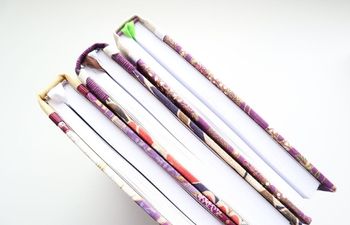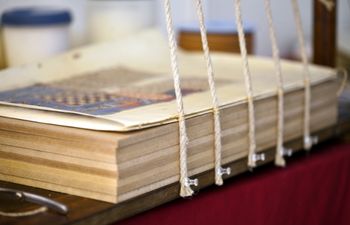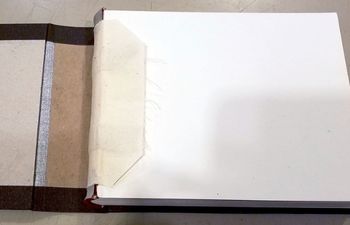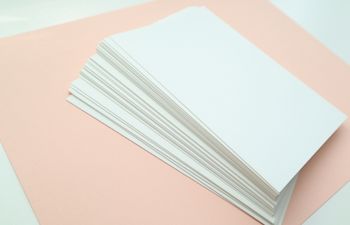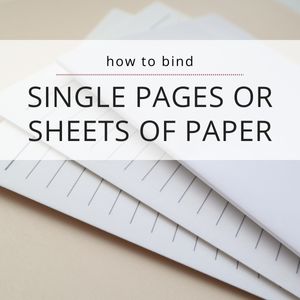No one wants an ugly book, but we all know they exist. Professional looking handmade books are structurally sound and uniform in appearance, but achieving this requires juggling many design elements. One often overlooked element is spine strip thickness. Since the spine strip sits in a highly visible area perpendicular to the cover, it can really impact the overall look and feel. Today, I’ll show you how to create visual balance with the right spine strip so you can achieve the uniformity we all swoon over.
What is a spine strip?
The spine of a book is the area where the pages are bound together.
The spine strip is a piece of card that defines and protects the spine from normal wear and tear.
A book case is created by gluing the spine strip and cover boards to a strong, yet flexible material like book cloth.
I’ve Made Every Mistake in the Book (literally)
Before jumping in, let’s review a few of my ugly books. Remember, everything I discuss on this blog is usually related to my own missteps or failures. While I might create a Frankenstein now and then, I don’t give up. And you shouldn’t either.
Exhibit A: crappy spine strips.
Notice how wide the spine strip is on the first two books (blue and cream) vs. the last book (pink). To make matters worse, all three books are using a spine strip with the same book board thickness as the covers. This creates two problems: 1) the strip dwarfs the poor headband and 2) it creates a “boxy” shape with improper balance.
If the eye is constantly drawn to one area, there’s a balance issue. Unless the area is a feature-forward design element, the eye should not land on it exclusively. Observers should gaze over the entire book from head to tail and feel like they can’t, for some reason, get enough of it.
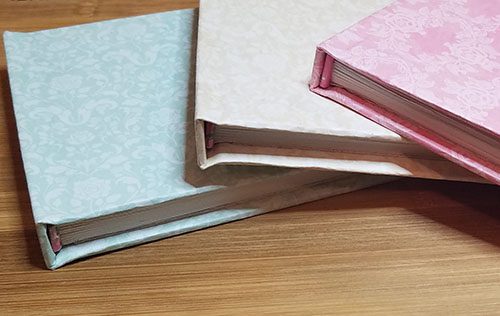
Spine Strip Material
A thick or sturdy card stock (220gsm, 100# or higher) is good for the spine strip, but thinner book board (0.5-0.7mm) can also be used. If you’re short on these supplies, the cardboard from a cereal box is a great substitute.
A good spine strip can be shaped with pressure, but remains firm.
Spine Strip Thickness
Now that we know what a spine strip is and the material used to make one, let’s talk about weight. The weight of the spine strip can dramatically change the visual balance of a book.
Spine strips in professional looking handmade books are created with thinner cardstock than the covers. As an example, if you have a 2mm cover board thickness, consider using a card of 0.7-0.8mm. For a 3mm cover board, 0.9-1.3mm would work well. The ratio isn’t exact, but it’s safe to say the spine strip should be about 1/2 to 2/3 the thickness of the cover boards.

Spine Strip Examples
I’m using two different spine strip weights in the following photo. The book on the far left has a spine strip that is the same thickness as the cover boards. See how it has that “boxy” shape? Now, look at the middle and far right books. Both strips have the same weight, but I’ve curved the middle book’s strip slightly to give it a different look.
If you look closely at all three books, you can see how the middle and far right books seem more balanced. This is because the strips are thinner than the cover board. The strips contrast, but don’t steal the show. They blend right in with the book, creating a uniform object that flows together.

Parting Advice
After all this talk of proper balance, I want to mention that if you only have one type of book board available and no cardstock, go ahead and use it. “Boxy” spines aren’t horrible, and there are other ways to add visual balance for a more professional looking handmade book.
I’ve said it before and I’ll say it again – you don’t have to be a professional bookbinder to make beautiful books. I’d rather you try than worry about these finer details!
Resources
- Learn all about book board, including thickness and book sizes, in Know the Difference | Book Board
- New to Bookbinding
Are you new to bookbinding? Check out my New Bookbinder Guide for helpful information.
Pop over to Instagram or Facebook if you have any questions or suggestions!
ALL my best,
Misty
